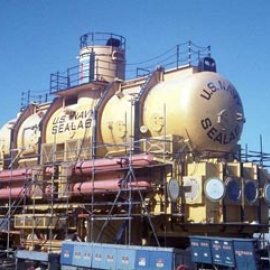A Salute to SeaLab
-
English
-
ListenPause
I’m Peter Neill, Director of the World Ocean Observatory. In order to keep up with the rapidly expanding world of ocean technology, I am a regular reader of Ocean News and Technology, an industry magazine, the editorial of which runs a full spectrum of ocean interests and innovations, of course emphasizing offshore applications for oil platforms, pipelines, and services, but also wind and tidal energy, research and exploration, the newest observation and data collection technologies, and even maritime history and underwater archaeology. An interesting feature in the January 2016 issue discussed the story of SeaLab, a program now celebrating a 50th anniversary of the first of three experiments in aquatic living as part of the US Navy’s Man-in-the-Sea initiative to understand how humans can best survive in exacting underwater conditions. The three SeaLabs pioneered living and working under the immense challenge of pressure and changing conditions, and contributed enormously to the development of tools and procedures that opened the ocean world to new and safe access through extended stay in an underwater habitat, development of breathing devices and medical protections, and understanding of the physical and psychological demands of such experience. Ocean News reports on a 1966 symposium in which H.A. O’Neal of the Office of Naval Research, describes three key innovations as follows: “1) The introduction of helium-oxygen reduced the danger of nitrogen narcosis at depths greater than 150 feet and decreased decompression times of deeper dives; 2) The introduction of the self-contained closed-mixed gas breathing apparatus which increased diver mobility by releasing from an umbilical cord to the surface; and 3) The introduction of saturation diving, increasing the ratio of useful working time to decompression time…The program engaged personnel from many disciplines – the Aquanauts, as they were called, as well as medical officers, psychologists, engineers, chemists, physicists, photographers, master divers, biologists, oceanographers, and other specialists.” According to the Naval Undersea Museum in Keyport, Washington, “The divers evaluated the structural engineering of the habitat. They worked on a mock-up of a submarine hull and tested undersea tools; they raised an old Navy jet fighter to the surface using a new ‘Foam-in Salvage’ technique; set up a weather station, mined ore samples, experimented with terrestrial plants grown in hel ium-rich hyperbaric environments and studied ocean floor geology. The program also produced the first ocean-to-space communication between Team 1 Aquanaut Scott Carpenter and Gemini 5 Astronaut Gordon Cooper. Much more detailed information about SeaLab and related endeavors, go to the Journal of Diving History, published by the Historical Diving Society, online at www.hds.org. In his presentation, H.A. O’Neal listed numerous outcomes of the SeaLab program to include working successfully in depths of 200 feet and more, adaptation to cold water conditions, the invention of heated suits, an understanding of the mental and physical capabilities in stressful conditions, new tools and techniques for salvage, performance criteria for selection of industrial and military divers, useful interaction between humans and marine mammals, methodology for scientific, biological, and geological ocean floor investigation, strategic pathways for development of new equipment, deep-water swimmer communications and underwater navigation electronics, and further development objectives for reliable underwater power generation and storage and integrated life support systems. He concludes, “In summary, a step forward has been made enabling us to move with greater ease in a hostile environment, and has shown those problem areas which must receive attention to permit us to work and live more easily, safely, and efficiently.” So, a salute to SeaLab and all the similar subsequent progress that has been made since its beginning, providing the tools and skills and knowledge that will benefit us all even though most probably applied by others in a place we will never see. We will discuss these issues, and more, in future editions of World Ocean Radio. World Ocean Radio is produced by the World Ocean Observatory. World Ocean Radio is distributed by the Public Radio Exchange and the Pacifica Network. Find our podcast on iTunes, and at World Ocean Observatory dot org.
The US Navy's SEALAB initiative is celebrating its 50th anniversary this year, with now three pioneering aquatic living experiments under their belts to help understand how humans can best survive in underwater conditions. In this episode of World Ocean Radio, host Peter Neill salutes the work of SEALAB, outlining their enormous contributions to the development of tools such as breathing devices and medical protections, as well as their contributions to the further understanding of the physical and psychological demands of surviving in an underwater habitat.
About World Ocean Radio
Peter Neill, Director of the World Ocean Observatory and host of World Ocean Radio, provides coverage of a broad spectrum of ocean issues from science and education to advocacy and exemplary projects. World Ocean Radio, a project of the World Ocean Observatory, is a weekly series of five-minute audio essays available for syndicated use at no cost by college and community radio stations worldwide. A selection of episodes is now available in Portuguese, Spanish, French, Swahili, and Mandarin, enabling us to reach 75% of the world's population. For more information, visit WorldOceanObservatory.org/world-ocean-radio-global.
Image
SeaLab III under construction
Credit
www.history.navy.mil
Resources from this Episode
< Ocean News & Technology, January 2016
< Naval Undersea Museum, Keyport, WA
< Journal of Diving History | Historical Diving Society
< 1966 Symposium | H.A. O'Neil, Office of Naval Research | Project SeaLab
- Login to post comments



